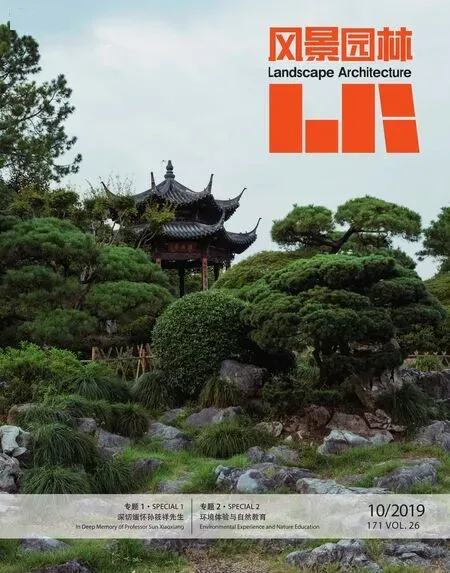生物友好型设计
——新加坡裕廊湖畔花园
2019-11-30安博戴水道
安博戴水道
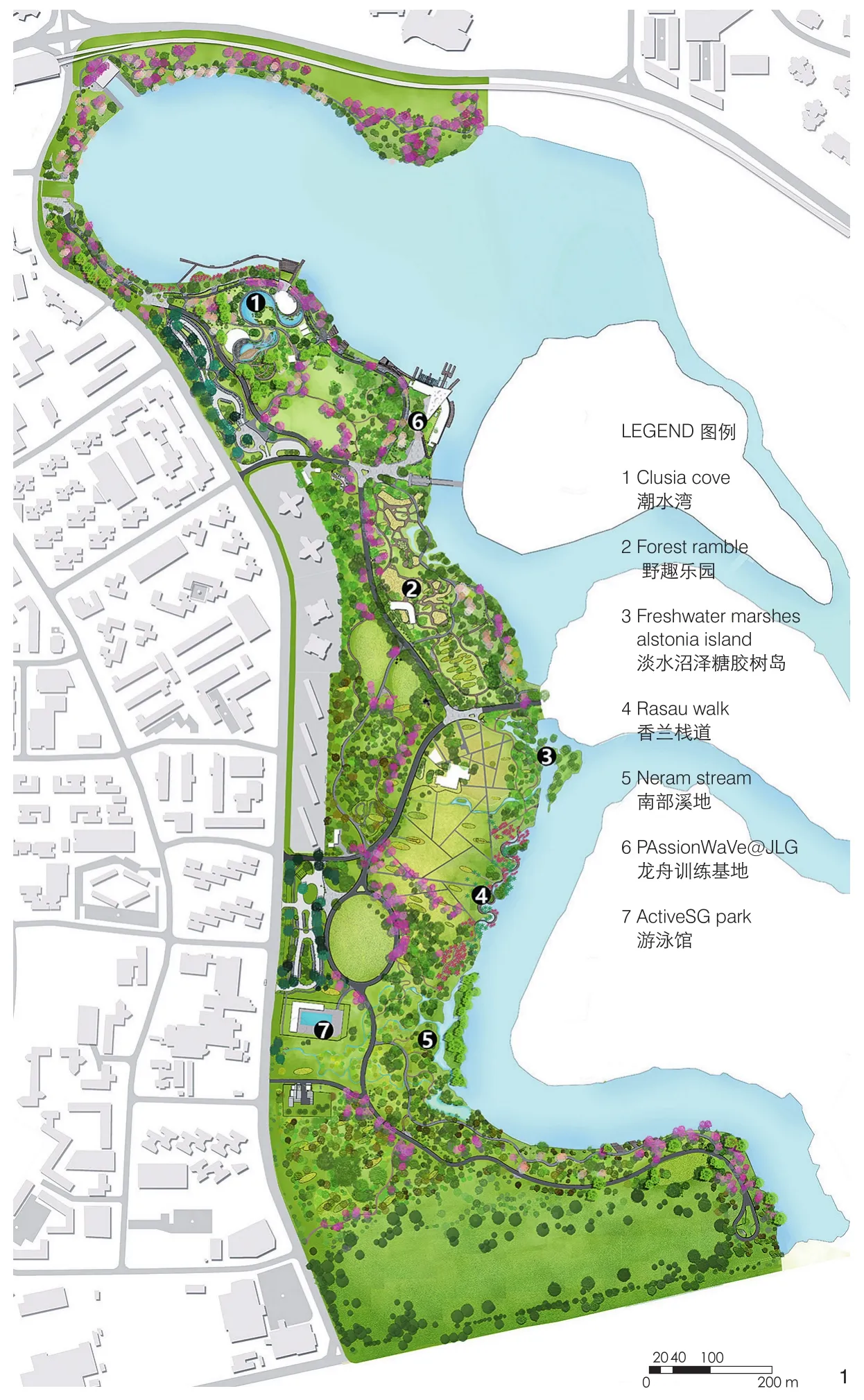
1 裕廊湖平面图Master plan
裕廊湖畔花园是裕廊湖花园一期开发地块,占地53 hm2。裕廊湖花园位于裕廊区的西岸,地处最核心区域,是新加坡第一个位于市区的国家级公园。裕廊区曾经是一片被红树林和淡水沼泽覆盖的泽国,是水鸟、蜻蜓、水獭、巨蜥和兰花、糖胶树、香兰草、红椰树等动植物的家园。新加坡建国后,为了发展远洋运输业,填湖造地,并将这片沼泽和湿地规划为工业园区。20世纪80年代,随着人口的大量增加,这片曾经的工业园区慢慢又转化为新兴的住宅区,并配有地铁、高速公路、学校、医院和商场,成为市民们的家园,但往日的生物多样性已不复存在。
安博戴水道在该项目中负责景观设计、水利生态设计和湖滨花园游乐场的设计咨询顾问。通过有效的生态修复设计,恢复泽国风光,为鸟类和昆虫类提供淡水森林栖息地,同时也为公众提供亲水乐园、野趣乐园、生态步道等,满足当下市民的生活、学习、健身需求。
湖畔花园的设计以生物友好型设计(biophilic design)为原则,关注自然层面,强调整体自然环境和生物栖息地。将人们的内在需求与自然功能结合,增强人们对环境和场所的情感依恋,用一种深刻而基本的方式来保护自然。
1 糖胶树岛和南部溪地
提高和改善野生动物的栖息环境,使游客能够享受自然和生物多样性,保持该地区的宁静是裕廊湖畔花园设计开发中需思考的关键因素。设计在恢复裕廊湖畔花园泽国风光的同时,归还动物们的旧日家园。
新建的糖胶树岛是生态修复后的水鸟家园,也是爱好者们的观鸟点。淡水湿地是裕廊湖区曾经最普遍的生态系统。这里的植物利用发达的呼吸根抵抗潮水的侵袭,如糖胶树(Alstonia spatulate)。这里的动物则适应了潮涨潮落,擅长利用水位的变化来觅食。落入公园中部区域的雨水经过生态水沟的汇集,注入重建的淡水湿地。
湿地和裕廊湖两者重现了裕廊湖曾经的生态群落。低水位的时候,人们可以走在湿地汀步上近距离观察上岸的巨蜥(Varanus salvator);高水位的时候,人们可以在观景台上远眺糖胶树岛上的苍鹭(Ardea cinerea)。
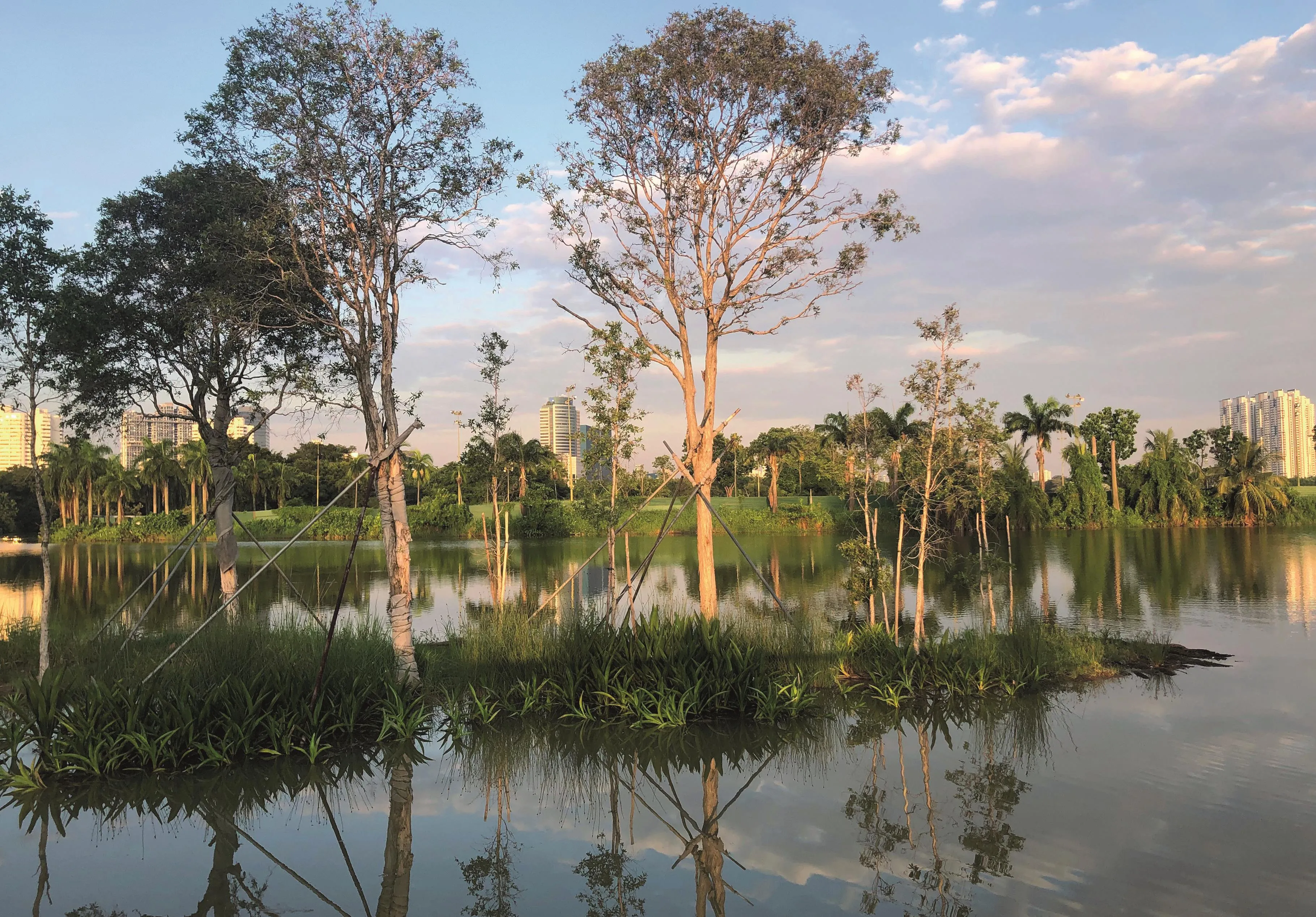
2 糖胶树岛Alstonia island
南部溪地区原本有一条普通排水渠,将附近的居住区、马路、学校的雨水排入裕廊湖。然而水渠会对江獭(Lutrogale perspicillata)、巨蜥的通行造成困扰,过于笔直和炎热的水泥壁,并不是它们爬行的理想河岸。于是在设计中拆除水渠,构建一片溪地,并在岸边建设多层嵌套平台,且保证动物的生活不被打扰,保持不少于55 m的距离,多层嵌套平台尺寸最小为1 m2,方便人行通过。
溪岸采用生态工法进行加固:石块能降低水速、减缓侵蚀;深根性的灌木和地被能稳固基岸;可降解的椰榈织物能在植物的根系成熟前,暂时固定土壤。相较于硬质的混凝土,生态工法能够进行持续的生长与自我修复,对水生生物和两栖动物更友好,同时能满足城市排水管道的泄洪需求。
2 香兰栈道和草甸
在裕廊湖的西部香兰栈道和草甸区域是鸟类和两栖类生活的河岸湿地带,设计中尊重植物生境,提高动物栖息地质量,也寓教于乐地向年轻一代介绍湿地生物,并供人们徜徉其中。这块区域原本只是一片水泥停车场,通过地形修复,被改造为一片高低起伏、缓缓向湖面延伸的草甸。
地势低的区域,通过生态改造打造了香兰栈道,沿岸种植了50多种适应潮汐变化的湿地植物,成了香兰草(Pandanus amaryllifolius)、红椰树(Cyrtostachys renda)、野菠萝(Oncosperma tigillarium)丛生的河岸,成了巨蜥和蜻蜓的家园,成了冠斑犀鸟(Anthracoceros albirostris)、苍鹭和江獭觅食的地方。根据湖泊的水位,湿地栖息地被水淹没,为水鸟提供食物和饲料,同时栈道可以带游客穿过这片经过修复的淡水沼泽森林,游客可以体验到各种各样的栖息地,观察到生活在这里各种各样的动物,如苍鹭、犀鸟和江獭。
地势高的区域种植了成片的红毛草(Pennisetum setaceum)和狼尾草(Pennisetum alopecuroides),打造一个适合鸟儿筑巢和捕食的环境。项目建成后吸引了大群叽叽喳喳的田鹨(Anthus richardi)出没。鸟巢形状的观鸟亭由场地里回收的雨树(Samanea saman)做成,人们可以躲在观鸟亭里暗中观察这些吵闹的小鸟。
连接这两片区域的是穿绕其中的香兰栈道。栈道300 m长,时而纤细,时而宽阔,纤细处绕过保留的孪叶苏木(Khaya Senegalensis)和雨树,宽阔处留有望向湖面的座椅。人们从栈道上走过,巨蜥从栈道下穿过。黄昏的时候,栈道两侧会亮起微弱的荧光,仿佛萤火虫在沼泽中飘荡,为人们指引方向,但又不惊醒睡梦中的动物。
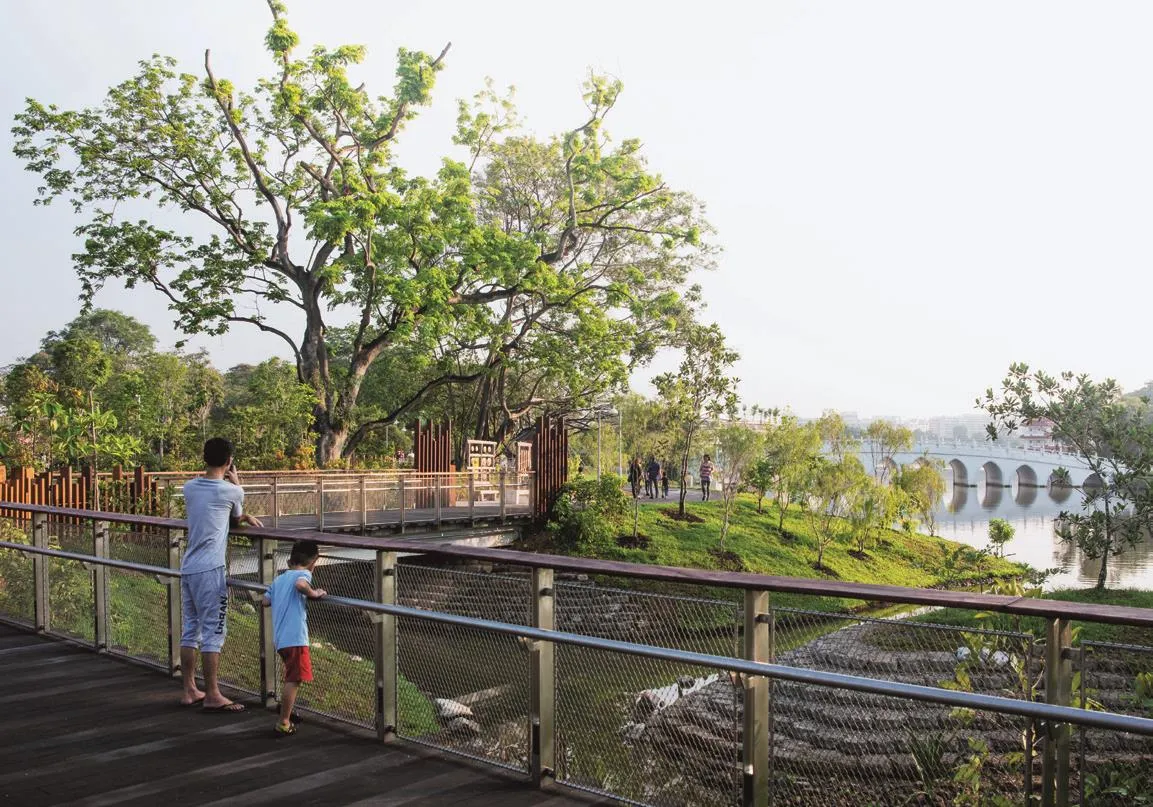
3 野趣乐园桥Bridge at Forest ramble
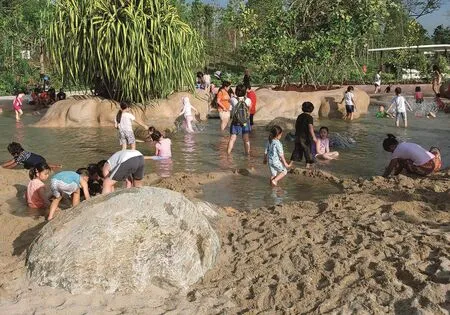
4 潮水湾Clusia clove
3 野趣乐园和潮水湾
野趣乐园占地2.3 hm2,受自然启发,打造了13个不同的探险主题区,让5~12岁的儿童能够在不同主题的游乐园林中探索自然生态,边玩耍边学习。孩子们可以在野趣乐园中模仿生活在淡水沼泽栖息地的湿地生物滑翔、跳跃。
像蝴蝶一样飘过池塘,像白鹭一样掠过水面,像青蛙一样跃过草丛,像蛇一样从树上游下,像猴子一样爬上藤蔓,像松鼠一样在枝头寻找平衡,像水獭一样挖洞,像螃蟹一样在洞穴里暗中观察……每一种动物都是裕廊湖区常见的,稍加留意就可以在树上、草丛中、溪水里观察到它们。
乐园大部分非承重结构的取材都是更为自然的石块和木材。它们有的摆放成溪涧落石和枯木的样子,仿佛水獭在其间工作;有的垒成鸟窝的形状,仿佛幼鸟在等待归巢的父母。倒下的病木和枯木,则被堆放在一起慢慢腐烂,慢慢长出蘑菇。它们是巨蜥和鸟雀觅食的地方,是生态循环的一部分。在腐烂之前,木堆和蘑菇又兼职孩子们爬高爬低的玩耍去处。
考虑到热带白蚁的危害和杀虫剂的毒性,所有有原木的区域,地基四周都由细密的铁纱包围。既无毒害,又能防止白蚁的钻入,保障乐园的安全。值得一提的是,其中一半的区域是无障碍区,所有的孩子都可以无差别地在一起玩。坐轮椅的小孩子也应该有一个尽情玩耍的童年。
潮水湾是模拟潮汐的生态池,也是玩水的去处。孩子们可以体验一个独特的水上游乐场,模拟潮汐模式,像水表面波纹、海岸的水运动等。并采用生态净化群落作为一个天然的水处理系统对回收的雨水进行净化处理,净化后的雨水在地下经过紫外线处理之后进入游乐场供孩子们玩耍。
潮水湾由5个相连接的月牙形池塘组成。第1个池塘是生态净化群落,回收自第4个池塘的水,经过层层水生植物和吸附层的净化,再经过地下的紫外线消毒管,最终达到安全洁净的水质标准,流入第2个池塘;第2个池塘是潮水浅滩,净化后的水像潮水一样从石缝中涌出又回落,孩子们可以在浅滩中追逐潮水,感受潮涨潮落,漫溢出的潮水流入第3个池塘—嬉水沙滩;沙滩上矗立着巨大的岩石,沙滩是小孩子们挖沙、堆城堡的地方,岩石之间是水闸,大孩子们可以用它们来控制水位,漫过沙滩的水,进入第4个池塘;第4和第5个池塘是生态水池,沿岸种有水生植物,被孩子们玩脏的水,在这里沉淀,化作植物的养分,池水最后循环回到第一个生态进化群落。
潮水湾通过循环生态净化,将回收水净化至游泳池水的标准,供孩子们嬉水。相较于使用常规的硫酸铜、消毒粉、净水剂进行水质净化消毒,生态净化群落不会对周边自然水体造成化学污染,不会对孩子们的皮肤造成刺激,它与周边的自然环境融为一体,让人们意识到大自然的惊人净化能力。
(编辑/刘昱霏)
项目面积:53 hm2
业主单位:新加坡国家公园局
景观设计:安博戴水道
水生态设计:安博戴水道,新加坡CPG集团
游乐场设计:安博戴水道,德国Kukuk
建筑设计:新加坡CPG集团
施工单位:鸿业私人有限公司
植物施工:Prince’s Landscape
游乐园施工:CT-Art Creation
设计时间:2014—2015年
施工时间:2016—2019年
开业时间:2019年4月27日
团队成员:里奥纳德·安,瑞恩·舒宾,麦勒·范迪克,谷凌一,幸嘉琪,穆罕默德·法伊兹,马修·本, 杜飞鹏
图片来源:安博戴水道

5潮水湾生物群落Clusia cove and Biotope
Jurong Lake Gardens will be Singapore’s third national garden, and the first in the heartlands. Lakeside Garden is the 1st phase of the developments at Jurong Lake Gardens,Located in the future largest commercial and regional centre outside Singapore’s city centre(Jurong Lake District). Strategically located to serve the communities in the western region Lakeside Garden is home to the largest children’s nature play garden in the heartlands, boardwalk and wetland trails, water sport facilities, as well as community gardening spaces. Ramboll Studio Dreiseitl is the lead landscape architecture, water engineering and playground design consultant of Lakeside Garden.
Identified as the first phase of development of Jurong Lake Gardens, Singapore’s third national garden and the first in the heartlands, Lakeside Garden is a 53 hm2site that looks to restore the landscape heritage of the freshwater swamp forest as a canvas for recreation and community activities. The development is envisioned to be a“people’s garden” accessible to all segments of the community and is a conscious effort to bring back the nature that was once unique to the area.
1 Ecotones
Before the early-mid 1900s, the area was a swamp that was teeming with flora and fauna.
The freshwater swamp, woodlands and grasslands are the primary ecotones that make up the garden. The ecotones are then further broken down into key habitat spaces, each with unique characteristics and plant types that are suited for the respective fauna. Over 3 000 existing trees are preserved within the site, with 200 trees transplanted. Existing big trees such as banyans and yellow flames are preserved carefully, which provide a connected corridor for wildlife and biodiversity. Bird, butter fly and dragon fly attracting trees and shrubs are specially selected to provide food source and nesting opportunities, ensuring a vibrant habitat with rich biodiversity. Rare species such as hornbills, buffy fish owls and otters are spotted to be regular inhabitant of the garden.
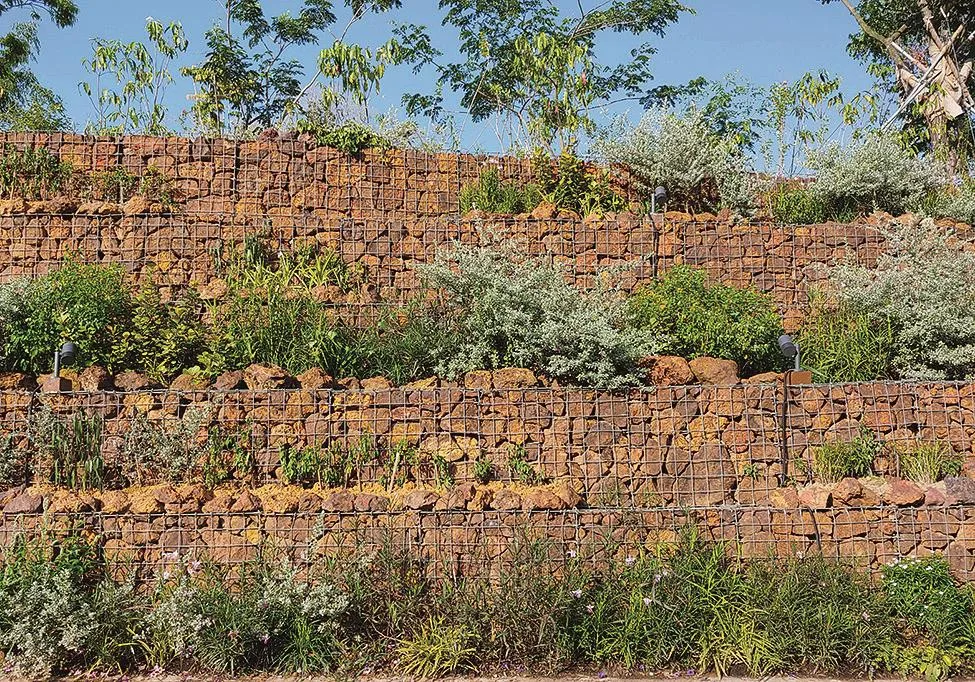
7 石笼墙Gabion wall
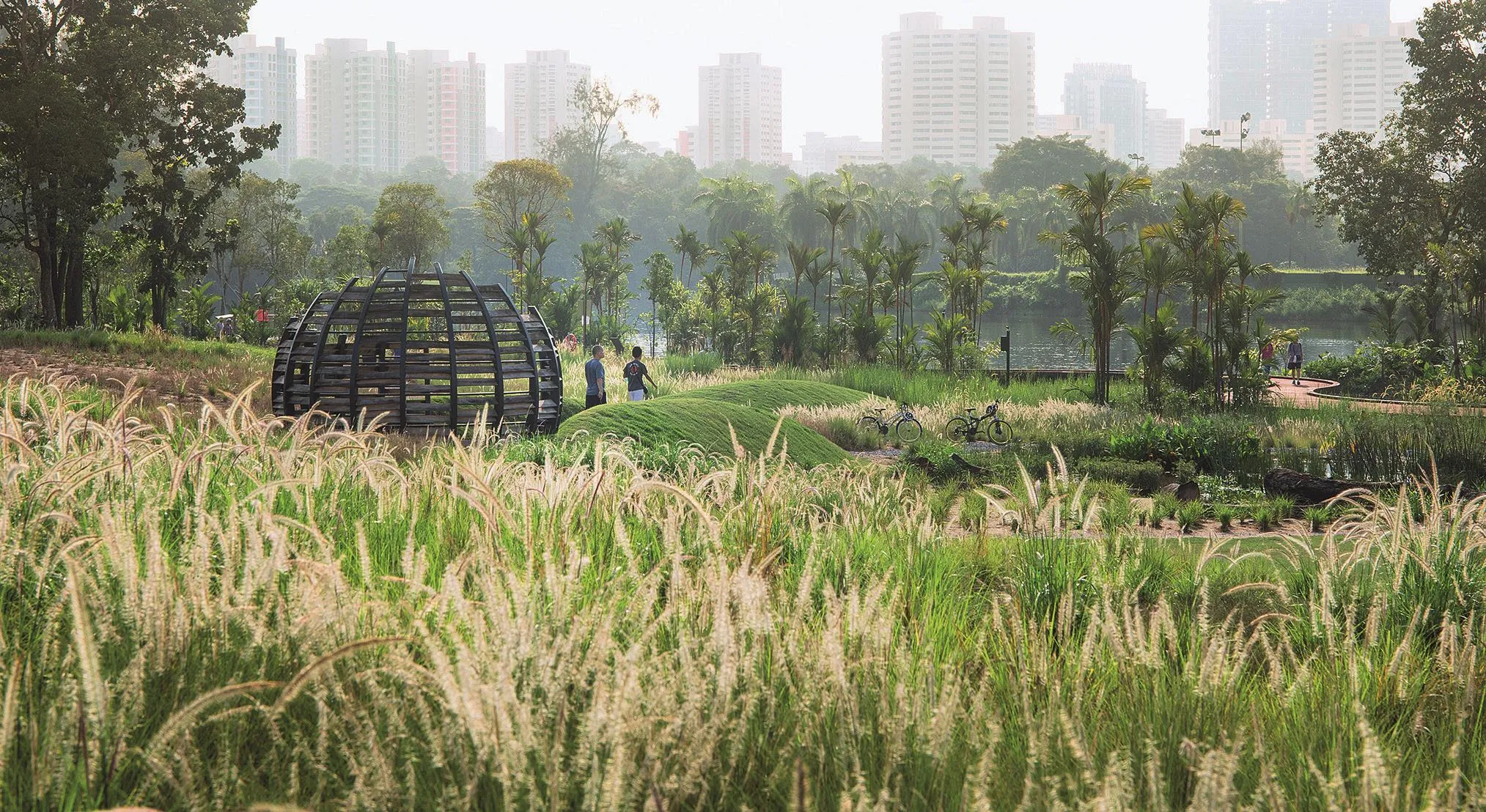
8 草甸区Grassland
Planted predominantly with Alstonia spatulate to reflect the natural history of the area, the Alstonia Island’s conditions are greatly influenced by changes in the water level of Jurong Lake. The island has conditions similar to that of a freshwater swamp, as it is constantly flooded when there are changes in Jurong Lake’s water levels. The dense vegetation and almost-permanently waterlogged conditions of the Freshwater Swamp Forest have led to the development of a unique habitat for flora and fauna. Singapore has lost many of its freshwater swamp forests since the early 1800s,largely due to development and land conversion for commercial agriculture, such as pineapple and rubber plantations. The area was a mangrove swamp forest before it was developed into an industrial estate in 1961.
As a series of braided waterways that adds up to 900 m winding around islands of trees, Neram Streams was previously a straight concrete drain that led from the road outside to the lake. With excavation depth as much as 6 m, the streams banks are precisely engineered through various bioengineering technique to ensure slope stability.The banks of the Neram Streams are planted with collections of tree species commonly found in tropical riverine forests, such as the Dillenia,Syzygium, Diospyros, Saraca and Barringtonia species. Clusters of Neram trees (Dipterocarpus oblongifolius) can also be found along the streams’bends.
The picturesque Grassland sits in between the Garden streams and the wooded areas. It forms part of the intertidal habitat, transiting from dry grassland of the inland area towards wet grasslands at the shore edge. With over 3.5 hectare in size, it aims to create a transition that provides refuges areas for both migratory and resident avian population, as well as food sources and nesting grounds. A series of mounds are located at the periphery of the vastly open grasslands, where 3 bird-hides are located at these mounds for bird watching activities. At dusk, grassland birds are seen to be hiding amongst the tall waving grasses, jumping from cluster to cluster, or flying in a flock against the sky in the vast grasslands.Besides being a hotspot for biodiversity, the soft yellow hues of the Grassland have also become the most popular spot for Instagram-worthy photos.The charming, alluring space is one of the rare spots in urbanised Singapore that is shared by both humans and wildlife in a non-intrusive manner.
Rooted in the middle of the open grasslands amongst the tall grasses is a sculpture in the shape of a bare tree made from recycled iron reinforcement bars salvaged from demolished steel-reinforcement from the site’s old pathways.Named as the Lone Tree, it is not just an artistic sculpture piece. This tree aims to serve similar ecological function as a snag or a dead tree in a wild meadow. This bare tree form becomes the perfect resting locations for either a feeding predator that is scouring the horizon for his meal, or temporary resting points for a flock of migratory bird of their journey. With long grasses waving in the foreground, the Long Tree with a perfect sculptural form is also found to be one of the most photogenic element within the garden.
Meandering along the water’s edge, the 300 m barrier free Rasau Walk offers visitors the opportunity to get up close with nature along the shoreline. Winding around islands of special palm collection and existing trees, moments of the tranquil grasslands and serene lakeside scenery are uncovered at various viewing spots. With a carefully engineered slope edge, the boardwalk sits within the transitional tidal edge that has varying water depths. Plants along Rasau walk such as the sealing wax palms, nibong palms, are adapted to cope with constant inundation. In the evening, the boardwalk will be illuminated with a soft glow along the edge,accentuating the curvatures of the meandering boardwalk.
2 Elements of play and water
Lakeside Garden is home to the largest children’s nature play garden in the heartlands. At Forest Ramble, a biophilic play space, children are encouraged to mimic the actions and motions of animals that inhabit freshwater swamps which were common in the Jurong Lake area.
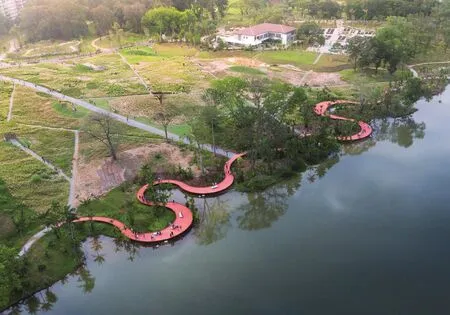
9 香兰栈道Rasau walk
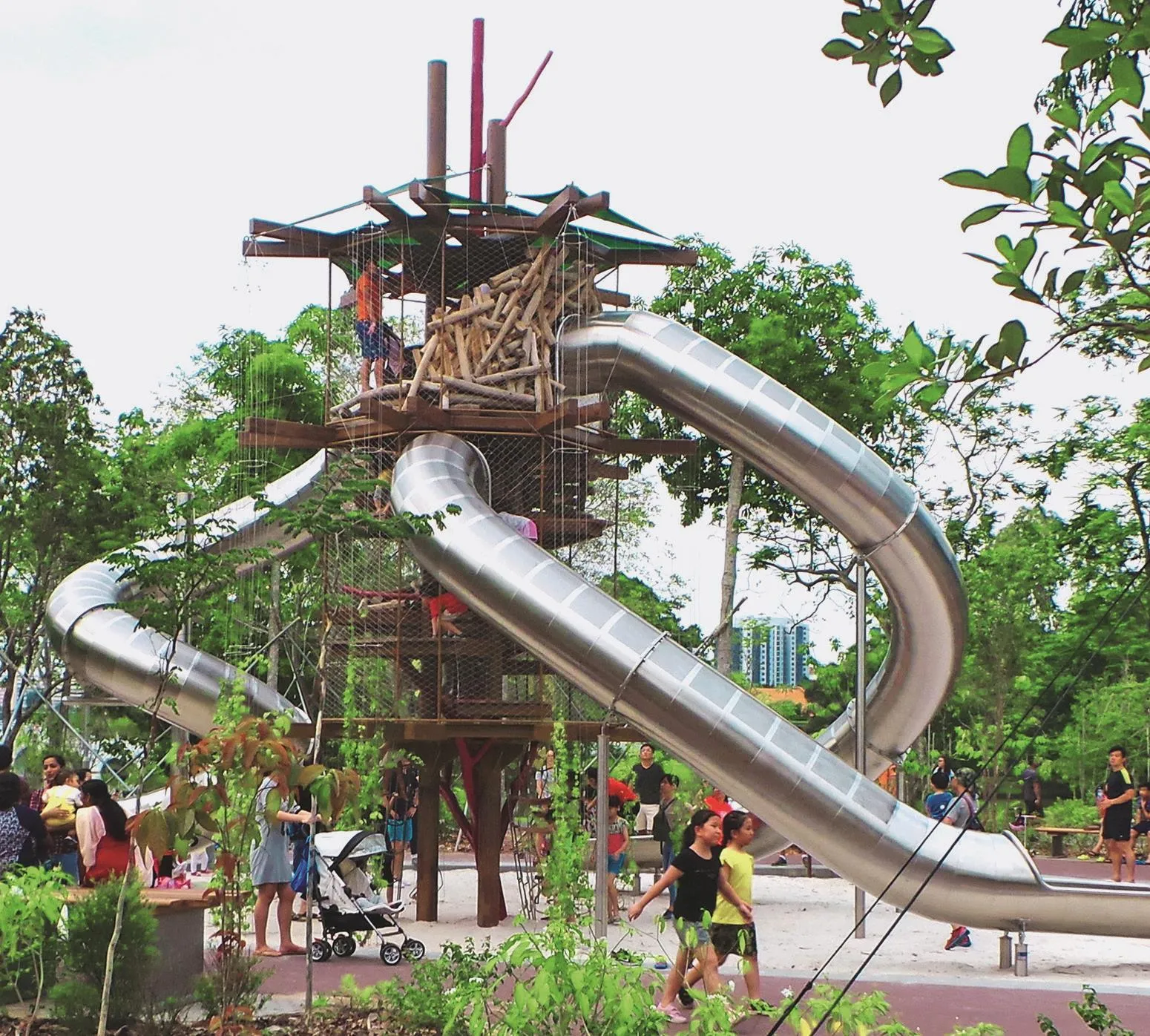
10 野趣乐园内的蛇形滑梯Snake tower at Forest ramble
They can hop about like a frog on the trampolines at the Frog Play zone, cruise in the air on a zipline and pretend to be a Heron flying from one nest to another, test their balance and agility by bouncing from one platform to another like a Squirrel, or glide down the slithering slide at the Snake Play zone. At this biophilic nature playground, they are also encouraged to come out with their own way of pretending to be any animal imaginable that looks to conquer the place and find their own path to an adventure within the garden.
To add to the play experience at Lakeside Garden, Clusia Cove is a fascinating, interactive water playground where children can experience the water movements that mimic the tidal pattern,surface ripples and directional currents similar to coastal shores. Children can put on their cutest swimwear, build sandcastles, and feel the currents tickle their shins at Clusia Cove, much like a day out at the beach. A three-hectare closed-loop water recycling system that treats water naturally is used for the water playground. Cleansing biotope which serves as a natural water treatment system and UV treatment are used to disinfect the water before being pumped into this play area. The cleansing biotope makes up of a series of cells filled with sand filter media, as well as semi-aquatic plants which absorbs excess nutrients from the water. It serves as a natural water treatment system before finer filtration and disinfection take place in the underground UV control room.
To improve the drainage system in the garden,Water Sensitive Urban Design (WSUD) elements such as vegetated swales and gravel swales are introduced as drainage conveyance measures. As a result, 12,000 m concrete drain was demolished,and a new 8,500 m concrete drainage and 4,750 m swales and streams was constructed. 100% of the catchment is conveyed through WSUD elements drainage before being released to Jurong Lake. Three concrete drains were transformed into completely naturalised streams, which provides new spaces for community and ecology along the streams.
(Editor / LIU Yufei)
